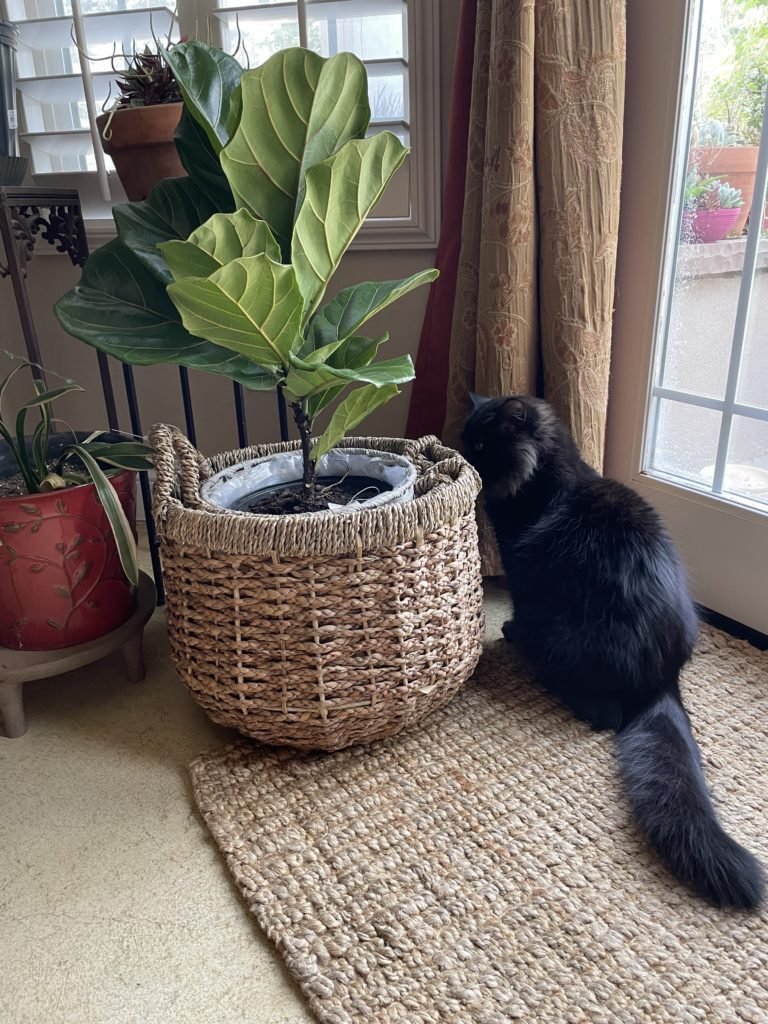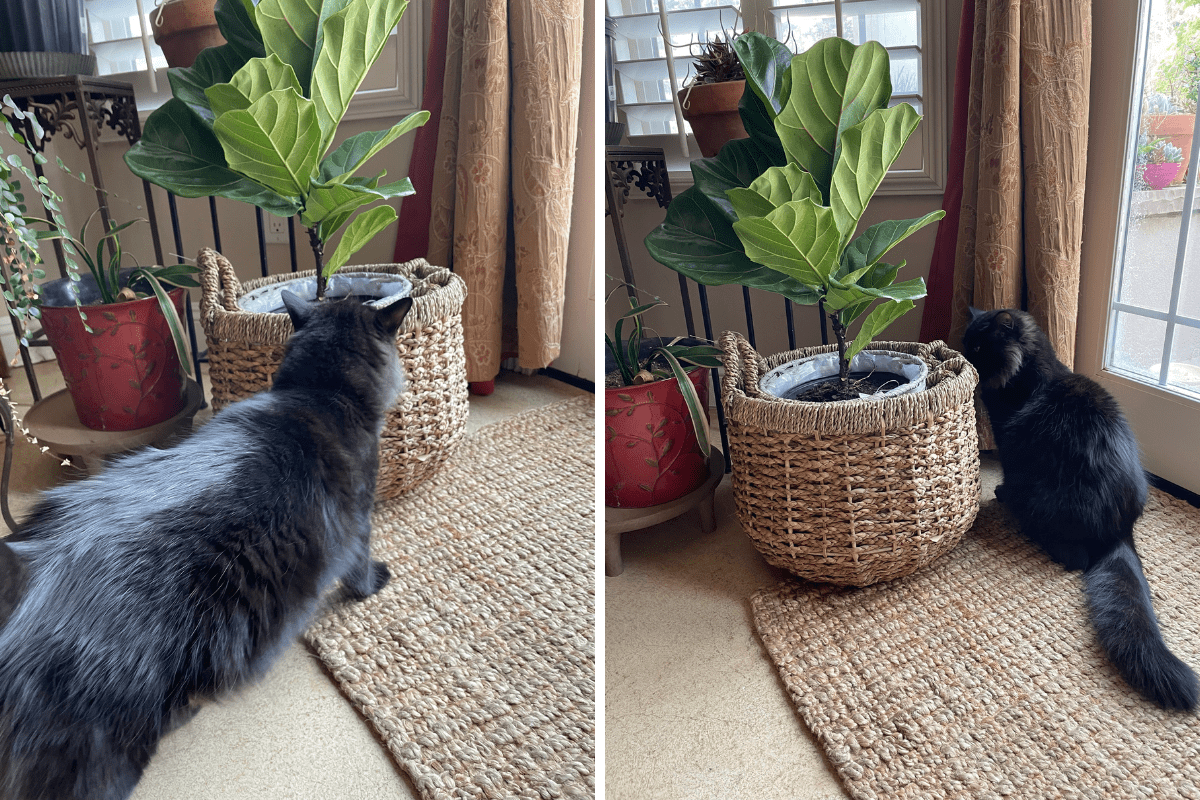I first made homemade spray to keep cats from eating plants because my mom’s cats were always getting into the pots of her indoor plants and chewing on the leaves.
Luckily, she doesn’t have any toxic plants. (Pet safe plants only in her home!)
BUT it was annoying nonetheless. Rather than buy cat deterrent spray, we wanted to see if we could concoct a homemade spray that could stop cats from eating plant leaves.
Long story short, we did it! So read on to fin learn about our quest to find a natural repellent for most cats that kept her cats out of the house plants.
Understanding the Cat-Plant Dilemma
First, to stop cats from eating your plants, you must become the cat. Or, you know, understand what causes cats to go bash*t over plants leaves and how to keep cats away. So here’s a quick breakdown.
Why cats are attracted to houseplants
Cats are curious creatures by nature and their attraction to houseplants can be attributed to a variety of reasons. Some cats are drawn to the texture and taste of certain plants, finding them an interesting diversion from their usual diet. Others may see your potted plants as a mini jungle, perfect for a game of hide and seek. The movement of leaves can also stimulate their predatory instincts, making your plants an irresistible plaything. However, it’s important to note that not all plants are safe for your feline friends. Some houseplants can be toxic to cats, causing a range of health issues if ingested.
Potential risks for cats and plants
While it’s fun for cats to explore and play with houseplants, it can pose potential risks for both parties involved. Certain plants can be harmful to cats if ingested, leading to symptoms like vomiting, diarrhea, and in severe cases, organ damage. On the other hand, cats can also cause damage to your beloved plants. From uprooting plants during play to using the plant pot itself as a litter box, cats can wreak havoc on your indoor garden. It’s crucial to strike a balance – ensuring your cat’s safety and keeping your plants intact.
Please note that the claims made in this article are based on scientific research and it’s always recommended to consult with a veterinarian for any health concerns regarding your pets.

Crafting Your Homemade Cat-Repellent Spray
Cats are adorable creatures, but when it comes to our precious plants, they can sometimes be a bit too curious for their own good. But don’t worry, we’ve got a simple, DIY solution that can help keep your feline friends at bay while ensuring your plants thrive.
Essential ingredients for your DIY spray
The key to an effective cat-repellent spray lies in the ingredients. Cats have a keen sense of smell, and certain scents can deter them. Essential oils are a great option here. According to a study published in Applied Animal Behaviour Science, cats dislike the smell of citrus. So, citrus essential oil or oils like lemon or orange can be very effective. You’ll also need water and a spray bottle. Remember, essential oils should be diluted before use as they can be potent.
Step-by-step guide to making homemade spray to keep cats from eating plants
Creating your cat-repellent spray is as easy as 1-2-3. First, fill your spray bottle with water. Next, add a few drops of your chosen essential oil. I recommend starting with about 10 drops per cup of water and adjusting as needed. Finally, shake the bottle well to mix the oil and water. And voila! You have your homemade cat-repellent spray.
Tips for effective use of your homemade spray
For the best results, spray your DIY cat-repellent around the base of the plants you want to protect. Avoid spraying directly on the plants as some can be sensitive to essential oils. It’s also a good idea to reapply the spray every few days or after heavy rain. Remember, this spray is a deterrent, not a guaranteed solution. It’s always important to monitor your cat’s behavior and adjust your approach as needed.
Remember, while this DIY solution is based on observed cat behavior, it’s always important to consider your pet’s individual reactions and consult with a vet if you have any concerns.
Other Natural Deterrents to Keep Cats Away from Plants
Cats love a good puzzle. And you know what cats hate? Gnar gnar smells. Barriers they can’t jump over. Cats that are cuter than them. Here’s a few things cats hate that can help protect your growing plants.
Scents that cats dislike
Cats have a keen sense of smell, and certain scents can be used as natural deterrents. For instance, cats are known to dislike the smell of citrus. You can use this to your advantage by placing peels of oranges, lemons, or grapefruits around your plants. Another scent that cats tend to avoid is the smell of certain plants like rosemary and lavender. You can plant these in your garden or use their essential oils as a deterrent.
Physical barriers and objects to deter cats
Physical barriers can also be effective in keeping cats away from your plants. Cats dislike walking on uncomfortable surfaces, so laying down chicken wire or pebbles around your plants can discourage them from approaching. Additionally, cats are not fans of water, so a strategically placed motion-activated sprinkler can serve as a deterrent. However, it’s important to note that these methods should be used responsibly to ensure the safety and well-being of the cats.
Plants that naturally repel cats
Certain plants are known to naturally repel cats. For example, the Coleus Canina, also known as the “Scaredy Cat Plant,” emits a strong odor that cats find unpleasant. Similarly, plants like rue and lavender can also deter cats. Interestingly, while cats are attracted to plants like catnip and silver vine, they also act as natural pest repellents. When cats rub, lick, and chew these plants, it leads to the release of iridoids, compounds that are known to repel mosquitoes. This is a win-win situation as it keeps both the cats off beautiful plants and pests away from your other plants.
Training Your Cat to Avoid Houseplants
Believe it or not, you can train your cat to learn to live without getting into your indoor plants. Here are a few of my favorite ideas that just couldn’t work with my mom’s cat gang, but I recommend them anyway.
Positive reinforcement techniques
Training your cat to avoid your precious houseplants can be a bit of a challenge, but with the right approach, it’s definitely achievable. One effective method is using positive reinforcement techniques. This involves rewarding your cat for good behavior, such as staying away from the plants, and ignoring or redirecting unwanted behavior. For instance, you could use treats, praise, or petting as rewards when your cat chooses to ignore the plants. According to a study published in Applied Animal Behaviour Science, positive reinforcement can be a powerful tool in modifying cat behavior.
Creating a cat-friendly garden
Another great strategy is to create a cat-friendly garden. This doesn’t necessarily mean turning your entire garden into a cat playground, but rather designating a specific area where your cat can play and explore safely. You could include cat-friendly plants such as catnip or cat grass, which can provide a more appealing alternative to your houseplants. A research in the journal Behavioural Processes suggests that providing alternative resources can effectively deter cats from unwanted areas because a cat will always want cat grass more than any other house plant you have in your home.
Here is a list of common houseplants that are safe for cats:
- Rattlesnake Plant
- Spider Plants
- Parlor Palm
- Calathea Orbifolia
- Ponytail Palm
- African Violet
- Baby’s Tears (Soleirolia soleirolii)
- Chinese Money Plant (Pilea)
- Paddy’s Wig
- Haworthia
- Money Tree (Pachira aquatica)
- Boston Fern (Nephrolepis exaltata)
- Areca Palm
- Cast-Iron-Plant (Aspidistra)
- Golden Bamboo
- Bromeliad
- Velvet Plant
- Polka Dot Plant (Hypoestes)
- Pineapple Plant (Ananas comosus)
- String of Pearls
- Baby Rubber Plant (Peperomia Obtusifolia)
- Snake Plant (Sansevieria)
- Prayer Plant
- Herbs
- Wheatgrass
- Christmas Cactus
Please note that while these plants are generally safe for cats, individual cats may have different reactions to different plants. Always monitor your cat when introducing a new plant into your home. If you notice any changes in your cat’s behavior or health, contact your vet immediately.
Protecting Your Plants from Cats
Cats are adorable, but when it comes to our precious plants, they can be a bit of a menace. Whether it’s using your potted plants as a litter box or seeing your greenery as a personal salad bar, cats can cause quite a bit of damage. But don’t worry, there are ways to keep your plants safe without causing any harm to your feline friends.
Choosing cat-resistant plants
Believe it or not, some plants are just naturally less appealing to cats. According to a study published in the journal Applied Animal Behaviour Science, cats are less likely to bother plants that have strong scents or rough textures. Plants like rosemary, lavender, and thorny species can be a great choice if you’re trying to deter your cat. However, always make sure the plants you choose are non-toxic to cats. The ASPCA has a comprehensive list of plants that are safe for cats.
Strategies for arranging your plants
The way you arrange your plants can also help keep them safe from curious cats. Cats are less likely to bother plants that are out of reach. Consider hanging plants or placing them on high shelves. If you have larger plants that need to stay on the floor, try arranging them in a cluster. Cats may be less likely to venture into a dense thicket of plants.
Covering soil to prevent digging
Cats love to dig in soft soil, but there are ways to make your plant pots less inviting. One method is to cover the soil with decorative rocks or pebbles. This not only looks nice but also creates a surface that cats don’t enjoy walking on. Another option is to use a layer of citrus peels. Cats dislike the smell of citrus, and it’s a natural way to keep them away. However, these peels should be replaced regularly to prevent mold growth.
Remember, every cat is unique and what works for one might not work for another. It might take a bit of trial and error to find the best solution for you and your feline friend.
Frequently Asked Questions
I’ve covered a lot so far but there are a few more questions you might have about keeping your fur baby out of your potted plants that didn’t fit anywhere else.
How can I keep cats from digging in my potted plants?
Cats are naturally curious creatures and sometimes, that curiosity leads them to your potted plants. One effective method to deter them is to use a physical barrier. You can place large, decorative rocks or pine cones on top of the soil, making it less appealing for the cat to dig. Another method is to use certain scents that cats dislike. For instance, citrus peels or certain essential oils like rosemary or lavender can be effective. However, always remember to use these in moderation and ensure they are safe for your specific plants and pets.
What natural methods can keep cats from eating plants?
Cats can sometimes develop a taste for certain plants, which can be a problem if those plants are toxic to them. To keep cats from eating your plants, you can try growing cat-friendly plants like catnip or wheatgrass for them to munch on instead. Another method is to use a homemade spray made of water and mild, cat-safe essential oils like lavender or eucalyptus. Spray this lightly on the leaves of your plants to deter your cat. Remember, it’s always important to introduce any changes gradually and monitor your cat’s reaction.
Why do cats show interest in eating plants?
Cats are carnivores by nature, but they often show interest in plants. This could be due to a variety of reasons. Some cats may eat plants out of boredom, while others may do it to induce vomiting if they’re feeling unwell. Some plants can also have a stimulating effect on cats, similar to catnip. However, it’s important to note that many common houseplants are toxic to cats, so it’s crucial to ensure the plants you have at home are safe for your feline friends.
Let me know in the comments what has worked for you! I would love for everyone to share their experiences and get a good list of resources out there 🙂
More How To Guides
- How To Get Rid Of Scale On Plants
- DIY Terrarium Table: How To Make A Table With Plants Inside
- How to Use Leca for Plants: Step-by-Step Guide with Pictures
- How To Use Grow Lights For Indoor Plants
- How To Propagate Peperomia Plants 2 Ways
- DIY Propagation Box With Grow Light
- How To Make Pothos Fuller (In 5 Minutes)
- How to Make a Moss Pole for Your Climbing Plants
- How to Make Potting Soil for Indoor Plants, Plus My Secret Ingredient
- How to Propagate a Split-Leaf Philodendron: Easy Step-by-Step Guide



